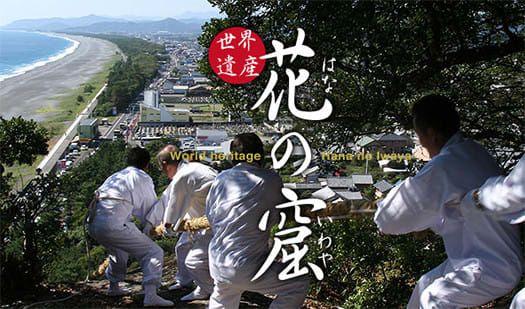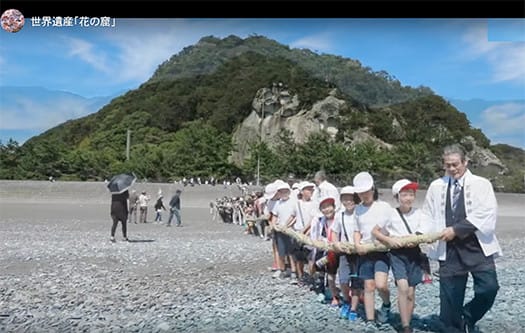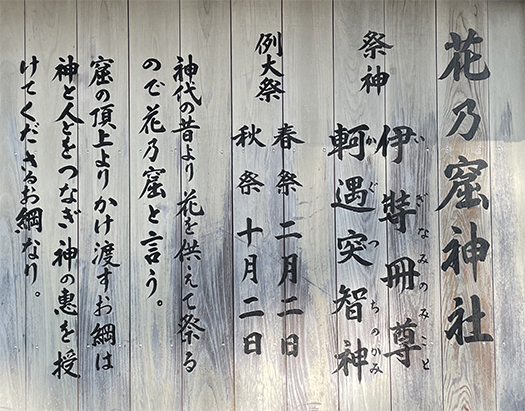



日本の神社信仰では必ず「注連縄」という習俗を持っている。この注連縄というものは稲作と非常に強い関連性を持っていると思われる。稲ワラを手作業で作り上げていく作業には合掌のポーズが必然化する。そういう体動作と造作物との間に直感的な連動性を感じています。
で、その神社のなかで「最古」と伝承されているのがこの「花の窟<いわや>神社」 。
三重県熊野市有馬町の太平洋に面した海岸線地形のなかに、特異な窟の露頭(花の巌)が顕現していて、それを天然の社殿として祀られている。祭神は国生みの母神・イザナミ尊。夫のイザナギとの間で神々を産み落としてきたけれど、火の神「カグツチノカミ」を産み落としたときに、その火に焼かれて亡くなったという伝承。
こういう国生み説話段階の言い伝えを保守する神社の祭礼として、「御縄かけ神事」が2月2日と10月2日の春秋に執り行われ続けているという。これは花の窟の頂上部分から社殿が面している太平洋の海岸砂浜に向かって「注連縄」を日本一長いともいわれる約170メートルほどつないでいくという奇祭。
神社の建物の中にあった説明文を読むと、この神事は日本列島に稲作が伝承した経緯としての「海からの渡来」を表現した厳然としたものであると記述されている。
その社殿の「始原性」はこの列島の縄文期の人びとの自然崇拝を残滓として明瞭に示しているように思えるし、国生みという伝承に込められたある「真実性」がうかがわれるのではないか。いわば縄文から弥生の世への列島社会の変遷を物語っているように感じられる。
言ってみれば皇統神話に描かれた「真実性」部分を表徴しているように感じている。もちろん科学的立場とは言えないけれど、歴史と伝承の中間地点、想像力の世界が可視化されている。稲作を象徴している注連縄が、海から花の窟の露頭につなげられることを、歴世繰り返してきた民人がいることがわかる。

日本書紀には以下の記述。「 一書曰伊弉冉尊火神(いざなみのみこと)を生み給う時に灼(や)かれて神退去(さり) ましぬ 故(か)れ紀伊国 熊野の有馬村に葬(かく)しまつる 土俗(くにびと)此神の魂(みたま)を祭るには 花の時に花を以って祭る 又鼓 吹幡旗(つづみふえはた)を用て歌い舞いて祭る」
日本書紀の成立は720年とされるけれど、その古代に於いてすでにこの「神社」が成立していたことが傍証されているわけだ。神社信仰の起源は不明だけれど、この花の窟神社は最古格であるとされている。北海道人としては神話と現実の符合の狭間に教えられることがある。
熊野への旅は日本の起源のなにごとかにもつながっている。
English version⬇
The "Hana no Kutsu Shrine" described in the Nihon Shoki (Chronicles of Japan): A Journey to Kumano and the Myth of the Imperial Family - 21
Although the name "Izanami" does not give me a sense of reality, I think there is something irresistibly true about a festival that symbolizes the "sea road" of the origin of rice cultivation in the archipelago. The myth of Izanami is not very realistic.
Japanese shrine worship always has a custom called "shimenawa. This shimenawa is thought to have a very strong connection with rice cultivation. The manual work of making up the rice straw inevitably involves the use of the palms together. I feel an intuitive linkage between such bodily movements and the construction of the work.
The "Iwaya Shrine" is said to be the "oldest" of these shrines.
In the coastal landscape facing the Pacific Ocean in Arima-cho, Kumano City, Mie Prefecture, a unique cave outcropping (hana no kutsu (flower rock)) has been revealed, and is enshrined as a natural shrine. The deity is Izanami, the mother goddess of the nation. Legend has it that she gave birth to gods with her husband Izanagi, but when she gave birth to Kagutsuchi-no-Kami, the god of fire, she was burned to death by the fire.
The "Onawa-kake ritual" has been held in spring and fall on February 2 and October 2 as a shrine ritual to maintain this legend of the birth of the nation. This is a strange festival in which a shimenawa, said to be the longest in Japan, is strung 170 meters from the top of the Hana-no-Kutsu Cave to the beach of the Pacific Ocean where the shrine building is located.
According to an explanation found inside the shrine building, this ritual is a solemn expression of the "arrival of rice from the sea" as a way of transmitting rice cultivation to the Japanese archipelago.
The "primitive nature" of the shrine building seems to clearly show the nature worship of the Jomon period people of this archipelago as a remnant of their nature worship, and it may suggest a certain "truthfulness" in the tradition of the creation of the nation. In other words, it seems to tell the story of the transition of the archipelago's society from the Jomon to the Yayoi period.
In other words, I feel that it represents the "truthfulness" depicted in the mythology of the imperial lineage. Of course, this is not a scientific standpoint, but it is a visualization of the world of imagination, the middle ground between history and folklore. We can see that the shimenawa, which symbolizes rice cultivation, is connected from the sea to the outcropping of the Hana no kutsu, and that there are people who have repeatedly done this in successive generations.
The Chronicles of Japan contains the following description. The god was burned when he gave birth to Izanami no Mikoto, and was therefore buried in the village of Arima in Kumano, Kii Province.
The Nihonshoki (Chronicles of Japan) is said to have been written in 720, but this is evidence that this "shrine" was already established in that time. The origin of shrine belief is unknown, but Hana-no-Kutsu Shrine is said to be the oldest of its kind. As a Hokkaido native, I am sometimes taught by the gap between myth and reality.
The trip to Kumano is connected to something about the origin of Japan.



















